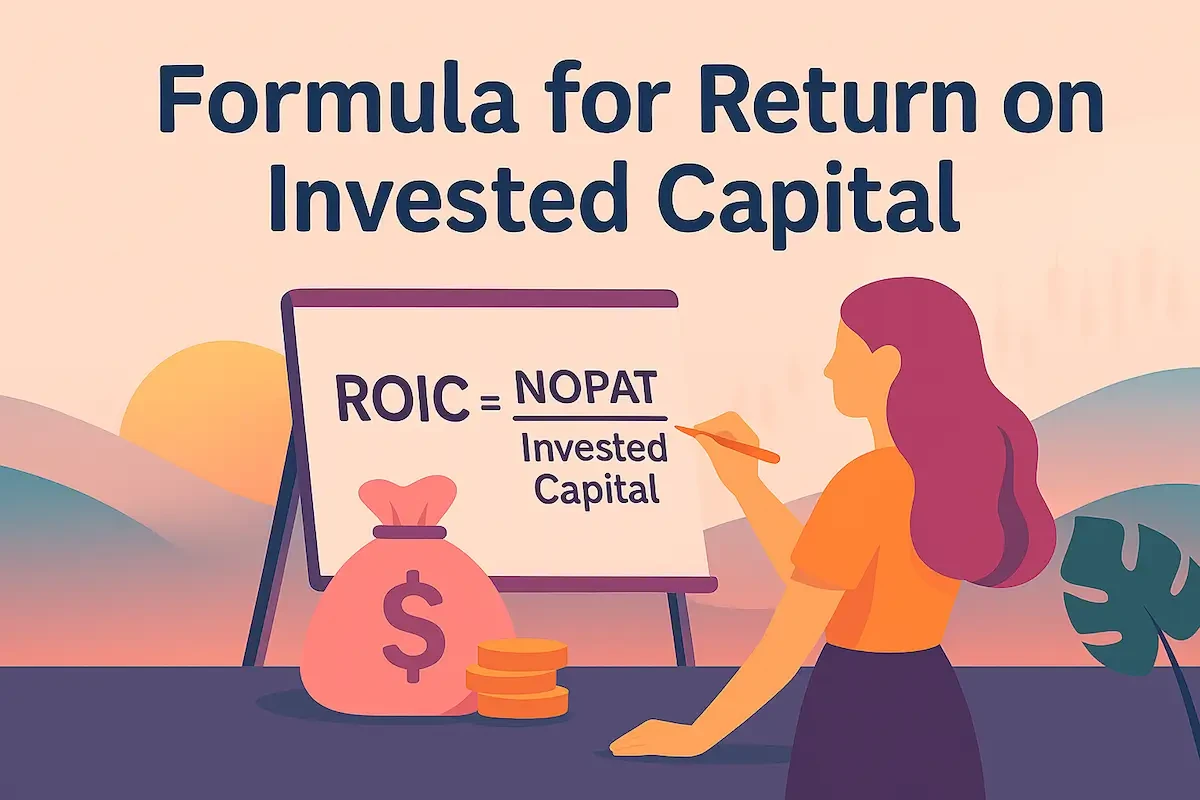Formula for Return on Invested Capital (ROIC): A Complete Guide
Return on Invested Capital (ROIC) reveals how efficiently a company turns invested dollars into profit. This guide breaks down the ROIC formula, step‑by‑step calculation, real‑world examples, and tips to boost this key metric.

TL;DR:
ROIC = Net Operating Profit After Tax ÷ Invested Capital. A higher ROIC means a company generates more profit per dollar invested crucial for spotting quality businesses and gauging management efficiency.
Intro: Why ROIC Matters to Investors
Return on Invested Capital (ROIC) shows how efficiently a company converts the money it controls—both debt and equity—into after‑tax operating profit. Because ROIC is compared to the firm’s cost of capital (WACC), it is one of the quickest ways to spot value‑creating businesses and strong management. If you learn only one profitability metric beyond P/E, make it ROIC.
What Is Return on Invested Capital?
ROIC answers a simple question: “How much after‑tax operating profit does each dollar of invested capital generate?” Unlike ROE or ROA, it blends both debt and equity, giving a cleaner, capital‑structure‑neutral view of performance.
Core Formula for ROIC

NOPAT (Net Operating Profit After Tax)
- Start with EBIT (operating income).
- Multiply by (1 – effective tax rate).
Invested Capital
- Interest‑bearing debt + shareholders’ equity non‑operating cash & investments.
Breaking Down the Components
1. Net Operating Profit After Tax (NOPAT)
- Pull EBIT from the income statement.
- Apply the firm’s effective tax rate (not statutory).
2. Invested Capital
- Long‑term debt
- Short‑term interest‑bearing debt
- Shareholders’ equity
- Minus excess cash / marketable securities (cash not needed for operations)
Step‑by‑Step Calculation Guide
1. Find EBIT (e.g. Apple FY 2024 operating income $≈123.2B)
2. Calculate NOPAT
- Apple effective tax ≈ 16 % → NOPAT ≈ $123.2 B × 0.84 ≈ $103.5 B.
3. Determine Invested Capital
- Apple invested capital for FY 2024 ≈ $142.7 B
4. Compute ROIC
- $103.5 B ÷ $142.7 B ≈ 72 %.
5. Interpret
- Apple’s ROIC far exceeds its 8–9 % WACC, signalling strong value creation.
(Numbers rounded for illustration.)
Interpreting ROIC Results
- ROIC > WACC: The firm creates value; keep or buy.
- ROIC ≈ WACC: Neutral; watch trends.
- ROIC < WACC: Capital is being destroyed; proceed with caution.
Industry Benchmarks (Typical “Good” ROIC)
| Sector | Average ROIC |
|---|---|
| Software / Tech | 20 % + |
| Consumer Staples | 10–15 % |
| Utilities | 5–8 % |
Common Mistakes
- Forgetting to adjust EBIT for one‑offs.
- Using net income instead of NOPAT.
- Failing to subtract excess cash from invested capital.
- Comparing ROIC without considering WACC.
How to Improve ROIC
Management playbook in two levers
- Raise NOPAT: Increase pricing power, cut costs, shift to higher‑margin products.
- Optimize Capital Base: Sell non‑core assets, reduce inventory, pay down unnecessary debt.
ROIC vs. Other Profitability Ratios
| Metric | What it Measures | Key Limitation |
|---|---|---|
| ROIC | Profit per total capital | Needs more data to compute |
| ROE | Profit per equity | Distorted by leverage |
| ROA | Profit per assets | Ignores cost of funding |
Conclusion & Key Takeaways
- Formula: ROIC = NOPAT ÷ Invested Capital.
- Why Care: It shows whether management is adding or destroying value.
- Rule of Thumb: ROIC should exceed WACC.
- Action Step: Add ROIC to your stock‑screening checklist and compare it with peers and history.
FAQ – Formula for Return on Invested Capital
What’s a “good” ROIC?
Anything above your estimate of WACC (typically 8–10 %) is value‑creating.
How often should I recalculate ROIC?
Use annual results for trend analysis; quarterly if you need fresher data.
Does buyback activity distort ROIC?
It can affect equity but also reduce cash. Adjust invested capital for excess cash to keep ROIC meaningful.
Is ROIC useful for banks?
Financials use different leverage; ROE and efficiency ratios are more common there.
